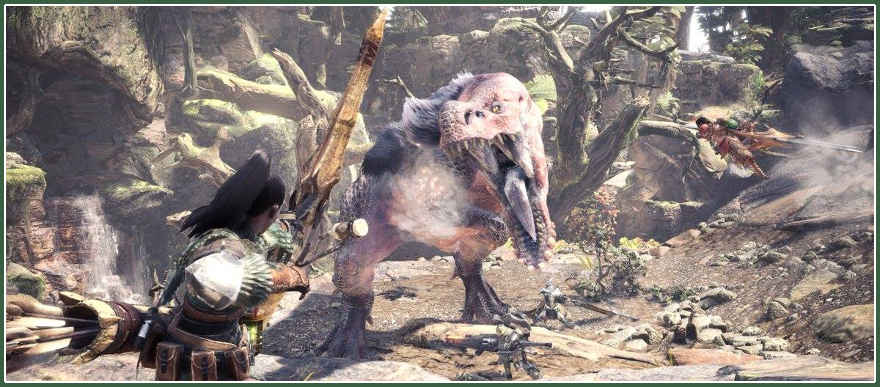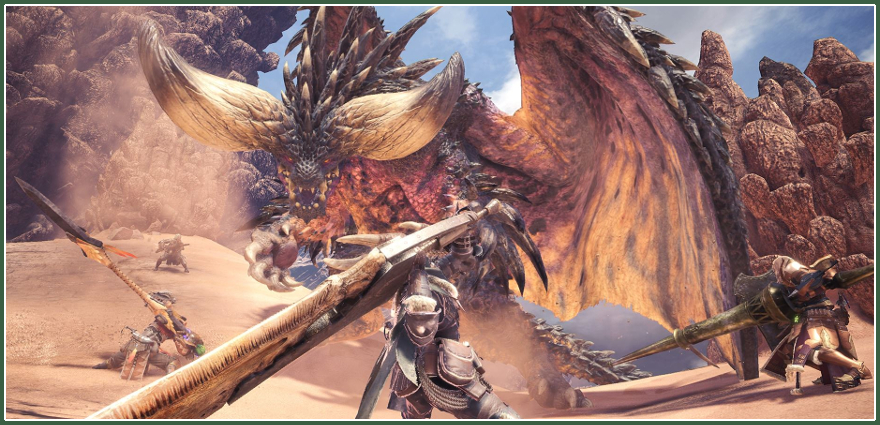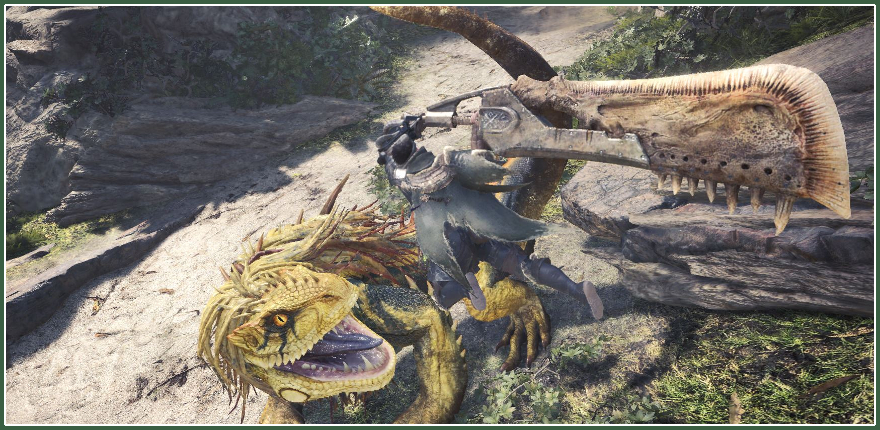
As the end of January draws ever closer, so too does the official console release of Monster Hunter: World, the latest entry into Capcom’s venerable series of action-RPGs that began nearly 15 years ago with the release of the original Monster Hunter on the PlayStation 2 in 2004. It’s a momentous occasion for fans of the series, as it marks the first time since 2013’s Monster Hunter 3 Ultimate – itself an enhanced remake of 2010’s Monster Hunter Tri – that a main-series title will get a Western release on a non-handheld console. Although the series has long enjoyed popular success in Japan, where handheld consoles have a much stronger core playerbase, it has remained a largely niche title in the West, where home consoles and PCs reign supreme.
So I don’t think it’s too much of a stretch to say that the imminent release of Monster Hunter: World on PlayStation 4 and Xbox One (and the PC release slated for this Autumn) marks the start of a new generation of Monster Hunter. With this new generation of the series, there’s bound to come a new generation of would-be Hunters eager to experience the franchise’s unique brand of skill-based combat and addictive “kill-carve-craft” gameplay cycle. While the Monster Hunter community, in my experience, is far and away one of the friendliest, most helpful communities I’ve ever had the pleasure to be a part of, and there are already dozens of wonderful resources to help fledgling players find their footing, I thought I’d do my part to put together a quick primer for any greenhorns who may be taking their first steps into the expansive, sometimes-overwhelming realm of Monster Hunter when MHW drops on the 26th.

Before we get started in earnest, it’s worth putting out there that Monster Hunter: World is truly a new generation of the series, and not just because it’s being released on current-gen consoles with shiny, updated graphics. It’s also bringing with it a whole slew of brand-new mechanics that have no precedent in the previous games, such as the mobility-enhancing Slinger grappling hook, the new playstyle-altering mantles, and the monster-tracking Scoutflies, to name a few. As I’ve yet to personally get my hands on the game, my insight into these new additions is limited. Instead, this primer will focus on the barebones basics that all Hunters should know before they cut their teeth in mortal combat against any of the game’s roster of deadly monsters.
With that in mind, let’s start with the most basic of basics: What is Monster Hunter, how does it play, and what makes it so special? Like I alluded to in the opening paragraphs, the game is, at its core, an action-RPG, but that’s a broad term, and MH doesn’t quite fit the mold of what most people think of when they hear the term. You may remember I described the core gameplay cycle as “kill-carve-craft,” and those three words encapsulate the game’s central mechanics.
The driving force behind the gameplay is, shockingly enough, hunting monsters – usually very big, very angry monsters who want you very dead. Every monster you kill, should you be fortunate and/or skillful enough to survive the hunt, can be carved up for parts, which can then be used to craft new weapons and armor with their own unique stats and skills, thereby giving you the strength to go hunt even bigger and badder monsters, and so on. Although many people associate the term “RPG” with things like experience points and levelling up, Monster Hunter is devoid of these; your equipment is your character progression.

There are 14 different weapon types in Monster Hunter: World, each with its own unique moveset and playstyle. From the hit-and-run tactics of the slow yet heavy-hitting Great Sword to the long-range artillery-launching Heavy Bowgun, every weapon brings something unique to the table, and although it’s inevitable that the community will eventually divide the weapons into tiers based on their popularity and overall efficacy, each and every weapon type can be an immensely deadly tool in the hands of an experienced Hunter, which brings me to my first tip:
Experiment constantly
The variety of weapons may be overwhelming to newcomers, and it can be tempting to just stick with the first weapon that’s put in your hand, but I would suggest taking your time to experiment with each of the different weapon types to see which one(s) fit your playstyle the best. Monster Hunter: World comes with a nifty training mode that allows players to learn the ins and outs of each weapon type in a safe environment, so be sure to take advantage of the opportunity to take every weapon for a spin at least once.
Even if you think you’ve already found “the one,” I’d urge you to keep experimenting anyway. For almost the entirety of my first two Monster Hunter games (Freedom Unite and Tri), I mained the Long Sword, which was probably the second or third weapon I picked up, then switched to the Charge Blade for almost the entirety of MH4U. It wasn’t until Generations rolled around that I decided to branch out and try some of the other weapons that I had previously written off as either too weak or, in the case of the Hunting Horn, too complicated to bother with. But once I took the time to get familiar with the Hunting Horn and learned that it is not, in fact, a “support weapon,” as many fledgling hunters assume, I regretted not having tried it sooner, and it quickly became my favorite weapon in the game.
Becoming proficient at any weapon takes time, though, and that brings me to my second tip:

Be patient
This may seem obvious, but whether it’s with yourself when learning to play a new weapon or with your fellow Hunters when a co-op quest isn’t going your way, patience is perhaps the single most important quality in a good Hunter. To the outside observer, Monster Hunter often seems like a straightforward hack-and-slash game, but the truth is it’s anything but. When you’re on a hunt against a monster for the first time – or the second, third, and hundredth times, for that matter – rushing in headlong will get you nothing except a swift and ignoble death.
I said a few paragraphs ago that in Monster Hunter, your gear is your character progression, and that’s true, but good gear will take you only so far. More important than your character’s progression is your progression as a player. Part of this, as mentioned, is finding the weapon that fits your playstyle and mastering its use, but an even larger part of it is becoming familiar with your foes.
Each monster in the game has its own moveset and combat style with its own strengths and weaknesses. Your job as a Hunter is to familiarize yourself with those strengths and weaknesses and use them to your advantage. Observe your enemy, learn its tells, know when to attack and when to defend, and above all else, don’t get greedy. Once you know what to expect from a monster and have its moveset down by heart, you should have no problem surviving battles against even the fiercest creatures the game has to offer.
In that vein, I would also recommend that new players go solo on their first few hunts against any new monsters. Although there’s no denying that co-op play is one of the most enjoyable and satisfying facets of any Monster Hunter game, it can be difficult to take the time to study a monster’s behaviors and pick up on its tells amidst the mayhem of a co-op hunt. While there’s certainly nothing wrong with getting a few helping hands against a monster that’s giving you trouble, taking the time to go one-on-one with each new opponent will make you a better Hunter in the long run.
And while proper weapon-choice, familiarity with your target, and raw skill will take you far in the hunting world, any Hunter worth his or her salt would be foolish not to make use of every available advantage, which brings me to my third and final piece of advice:

Be prepared
This is the one thing that Boy Scouts and Hunters have in common. Proper preparation before setting out on a hunt can often be the difference between a triumphant victory and a humiliating defeat. Although the Hunter’s Guild provides all Hunters with a few basic supplies at the start of a quest – usually some rudimentary first-aid potions and some field rations – the Hunters themselves are responsible for acquiring and bringing any additional tools they may need, and believe me, you’re going to need a lot of them.
The first part of being appropriately prepared is gathering crafting materials on your hunts. Monster parts are important for crafting and upgrading your equipment, but that’s not all you’ll need to survive; during your expeditions into the wilderness, you’ll come across a variety of harvestable resources, such as herbs, mushrooms, bugs, and more. Almost all crafting items are important to some extent or another, but there are a few you should make sure to gather in great quantities: Herbs and blue mushrooms are the ingredients needed to create standard healing potions, and adding honey to potions will turn them into considerably more potent mega-potions, which you’ll almost certainly be needing lots of.
Beyond that, you’ll want to make sure to maintain a healthy supply of raw meat, which you can then cook to create stamina-restoring steaks. There are plenty more, as well – antidote herbs for, well, antidotes, for instance – and you never know when any given item will come in handy, so at least for your first handful of hunts (especially if they’re in a new environment), I’d recommend grabbing everything you can get your hands on. This is another great reason that new players should go solo for at least the first portion of the game, so you can run around and gathering resources to your heart’s content without worrying about slowing down the rest of the party.

The second part of being prepared, of course, is actually using those materials you’ve gathered to craft consumables and tools, and then – and this is crucial – actually bringing them with you on a hunt. Before any hunt, you should consider two things: What am I hunting, and where am I hunting it? Answering the first question requires a bit of knowledge about the monster you’re hunting, whether acquired from first-hand experience or alternative sources. Does it inflict status effects? If so, be sure you bring items to remedy them. If you’re fighting something that uses poison, you better believe you’re going to want all the antidotes you can carry.
The second question can usually be answered by common sense. If you’re going to be hunting a monster in a hot environment, like a desert or a volcano for instance, you’re going to want to bring along some cool drinks to beat the heat; on the flip-side, if you’re hunting a monster in a particularly cold area, like an arctic island or an icy mountain peak, you’re going to want hot drinks to help you stay warm. Having the right tools and consumables for the situation at hand can be the deciding factor in whether you return with a haul of fashionable monster parts to make that pair of boots you’ve been wanting or with little more than a battered body and a bruised ego.
Although this has been only a brief and very general overview, I think that all fledgling Hunters should keep these three things in mind as they take their first steps into the beautiful and savage lands of Monster Hunter: World. For those of you who are craving more specific and in-depth guides to the game, hang tight—we’ve got you covered. Later this week, we’ll be taking a look at each of Monster Hunter: World’s 14 weapon types, for those of you who can’t quite decide which one you want to try first, and of course keep an eye out for even more comprehensive coverage when the game goes live on the 26th.















